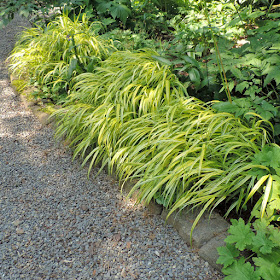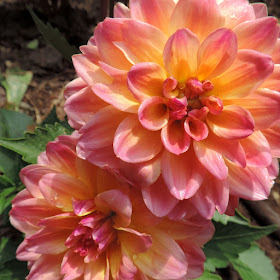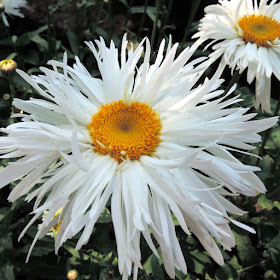The garden nurseries have been busy starting seeds and stocking their shelves for the onslaught of shoppers to brighten their yards, porches, and containers.
I thought I'd share with you some perennials that you might be interested in trying this year in your gardens. Some of these photos were taken from the Henderson Garden tour from last summer. If you missed my blog post on the Garden tour you can check it out by clicking on this link: Henderson NY Garden Tour.
 |
| Japanese Forest Grass (Hakonechola) |
The photo at right features a variety of Hakonechola grass (or Japanese Forest Grass). I'm not sure of the variety. This grass will grow in the shade and will do best in moist soils. I think it's a nice edging or filler grass. You can also plant it in containers. I'm not sure if it will survive a winter up north in a container because the roots might freeze if they are not protected. This grass will spread by rhizomes, but it is a slow grower and not invasive. In the colder climates of our area this grass will die back, but will return in the spring. In warmer areas of the country this grass will remain green. The grass will grow 18"-24" tall and has an arching habitat. The grass comes in many shades of green and may also be solid or striped. Most varieties are variegated with white or yellow stripes. This plant is best suited for USDA Zones 5-9.
 |
| Hakonechola grown along the edges of this path with other perennials. |
Fringed Shasta Daisy (Leucanthemum). This is a semi to double Shasta Daisy. It is sometimes referred to as a 'Crazy Daisy'. It is very prolific in its flowering. If continuously deadheaded, it will flower for several weeks in the garden. They will mix well with other perennials in your flower beds. The Fringed Shasta Daisy will grow 24"-28" tall. They require full sun (at least 6 hours) and well drained soil. Winter drainage is very important for successful plants. This perennials hardiness zone is 5-9. It is usually short-lived so it's best to divide the plant up in the spring or fall every two to three years for propagation. These flowers also make an excellent cut flower.
I'm not exactly sure what the flower at right is, but after a search on the Internet I believe it to be a variety of Heliopsis. There is a similar variety called 'Sunstruck' which I think could very well be this flower.
The leaves add a nice effect to the garden and when the flowers are finished blooming you still have the contrast of the variegated leaves. This plant prefers full sun and average to moist soil. They grow about 16" tall and are very easy to care for. They also attract butterflies and make a good cut flower. Another name for this variety is False Sunflower. It is also a native perennial and it is hardy to zone 4. The plant will flower from spring through summer.
 Dahlias are a tuberous-rooted tender perennial. They usually start blooming in mid-summer when other spring and early summer perennials are finishing up. The flowers range in sizes from 2" miniatures to 10" blooms called 'Dinner Plate Dahlias'. And they also vary in the height from 8" to 5' tall. Many dahlias are now grown as annuals. But if you want to overwinter the bulbs you have to dig them up in the fall before a heavy frost and store them in a cool dark place that does not freeze. Then plant the bulbs in the spring after the danger of frost has past.
Dahlias are a tuberous-rooted tender perennial. They usually start blooming in mid-summer when other spring and early summer perennials are finishing up. The flowers range in sizes from 2" miniatures to 10" blooms called 'Dinner Plate Dahlias'. And they also vary in the height from 8" to 5' tall. Many dahlias are now grown as annuals. But if you want to overwinter the bulbs you have to dig them up in the fall before a heavy frost and store them in a cool dark place that does not freeze. Then plant the bulbs in the spring after the danger of frost has past.To plant dahlia tubers, dig a deep hole and add compost or well-rotted manure. Then work in a 5-10-5 or 5-10-10 fertilizer according to instructions. Here are more complete instructions for planting dahlias: Growing Dahlias
Here's to your dreams of lazy, sweet spring and summer afternoons basking in the sun and enjoying your view of nature's marvelous wonders of sweetly scented flowers, the birds singing, and glorious blue skies.
It was one of those March days
when the sun shines hot and the wind blows cold:
when it is summer in the light, and winter in the shade.
~ Charles Dickens, Great Expectations
Thanks for stopping by.
Feel free to leave a comment~





Thank you Sue. As always, beautiful pictures and valuable lessons.
ReplyDeleteThank you, Kay! I'm glad you liked it!
DeleteI have Crazy Daisy in my garden, but it is not a variety I particularly enjoy. They sometimes get deformed for no reason that I am aware, unlike the more common Shasta Daisies. It must be weather related or insect damaged because some years they are fine.
ReplyDeleteSue you have highlighted some great plants. I have tried them all, and plan to grow dahlias again this year...the heliopsis love my garden and come up every year although 'Sunstruck' does not last and neither do the fancier Shastas. Here's to a fabulous spring!
ReplyDeleteThank you, Donna. I have tried some fancy Shastas, and you are right, they do not last and at the time I did not realize that I should have divided them up every few years to keep them from dying out. I like things in my gardens that do not require a lot of maintenance for that same reason.
DeleteYes, looking forward to a beautiful spring!
wonderful, thank you or sharing xx
ReplyDeleteThank you, Audrey. I'm glad you liked it!
DeleteHow about the weather this week? It seems like winter still has a grip on us. I love the gravel path. 'Sunstruck' is pretty yet it looks like the leaves have a virus, even though that is bred into the plant. That textural splash would bother me a bit trying to get a compatible partner for the plant.
ReplyDeleteI can't believe the weather Upstate NY is having. Syracuse got about 6"+ in several areas. I didn't even notice the leaf color variation on 'Sunstruck' at first because it was planted near the fringed daisies and those caught my eye. You really had to look close at them to see the variegation.
Delete